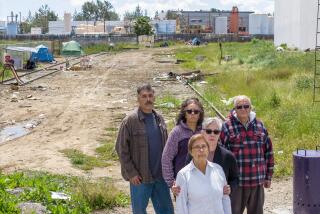Federal court rejects delay of N.M. power plant pollution controls
A federal appeals court has ruled that the owners of the San Juan Generating Station, a huge coal-fired power plant near Farmington, N.M., must continue with plans to install strong pollution controls. Several California cities purchase electricity from the plant.
The federal Environmental Protection Agency ruled last fall that the plant was required to install strong “selective catalytic reduction,” or SCR, equipment to cut its yearly output of 16,000 tons of ozone, fine particulate matter and other pollutants in order to meet federal standards.
The plant’s owner, energy company PNM, is appealing the EPA ruling, and the company and New Mexico Gov. Susana Martinez had motioned to delay the implementation of those controls until the appeal is decided. The U.S. 10th Circuit Court of Appeals denied the motion Thursday in a ruling only a couple of sentences long.
“The courts have said they could not delay this implementation. However, PNM and the governor are still appealing the decision, not the stay, but the EPA ruling. So I wouldn’t say that the court has come to a conclusion,” said David Van Winkle, energy chairman for the Sierra Club in New Mexico. The group has been involved in fighting pollution from the plant since the early 2000s.
The conflict, says PNM, is really not whether there will be pollution-control equipment installed, but what kind. The EPA had mandated the SCR gear after New Mexico failed last summer to meet a federal deadline for an implementation plan to meet air-visibility standards.
Since that time, however, the state has filed its plan, which is to install lower-cost “selective non-catalytic reduction,” or SNCR, equipment. PNM and New Mexico are appealing the EPA ruling so that the cheaper state plan will be taken into consideration.
PNM’s representatives say the state plan is about one-tenth the cost of the EPA proposal. They says they have received estimates on the SCR technology starting at $750 million and topping $1 billion (The EPA’s estimate was $345 million), while cost estimates for the SNCR technology are around $77 million. According to the EPA ruling, the controls must be in place by September 2016.
“We also asked for an interim stay because the five-year EPA deadline is so aggressive that we have to begin planning now to install that technology; it’s not something you do overnight,” said PNM spokesperson Don Brown. “We’re already spending money, we will spend additional money this summer, all the owners will, to install a technology that the court may find is unnecessary to meet the federal rule. We think that it’ll take a year or two for the court to decide the case on its merits.”
The higher-priced SCR technology also reduces greenhouse gases like nitrogen oxides.
Whichever method is used, PNM plans to pay for it with rate hikes. In a Saturday story in the Albuquerque Journal, nonprofit groups that have wrangled with PNM over rate hikes were angered by the 10th Circuit decision because it would lead to higher energy cost for consumers.
PNM has already put out a request for bids on the more expensive SCR technology, and company officials are moving forward with that plan. However, they are also asking the EPA for an administrative stay.
Last week’s ruling, however, came on the heels of a Sierra Club report that found that at the same time PNM was fighting the more costly pollution controls, it had dramatically increased its rates and its profits, while not meeting state energy-efficiency and renewables targets.
“Instead of getting wrapped up in costly litigation, New Mexico could follow the lead of many states that are closing coal plants from Pennsylvania to Illinois. PNM should follow Arizona Public Services’ [owners of the nearby Four Corners plant] lead -- immediately shut down one of San Juan coal units, with a phase-out plan to shutter the rest. The governor should be holding PNM accountable for their corporate transgressions -- poisoning our air and water -- not using taxpayer dollars to pay back campaign contributors who pollute New Mexico,” said Mariel Nanasi, executive director of New Energy Economy, which has fought for pollution controls.
“They’ve increased rates by $182 million since 2008 in three different rate increases,” said Van Winkle. “And surprisingly enough, about 80% of that has resulted in increased pre-tax earnings for that business unit, and not very much has been invested in energy efficiency or renewables -- only about 6% of that $182 million. Our opinion is that PNM should be investing more money in energy efficiency and renewables.”
Along with the Four Corners Generating Station, the San Juan plant has long been a target of environmentalists and Native American activists who say that pollution from the plants greatly affects the health of residents who live downwind of the plants.
A 2006 California law, SB 1368, prohibits the state from purchasing power from plants that do not meet California emissions standards for greenhouse gases such as co2. The San Juan plant does not meet those standards, but its current purchase agreements do not expire until 2022.
“What we really think makes sense is that they would transition some of their coal facilities to clean energy over the next several years or few years, and to get less dependent on coal,” Van Winkle said.
ALSO:
Wolf trek shows importance of wilderness
More Americans now believe in global warming
Organic farmers’ case against Monsanto thrown out by court





